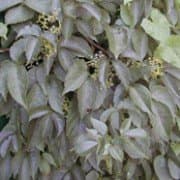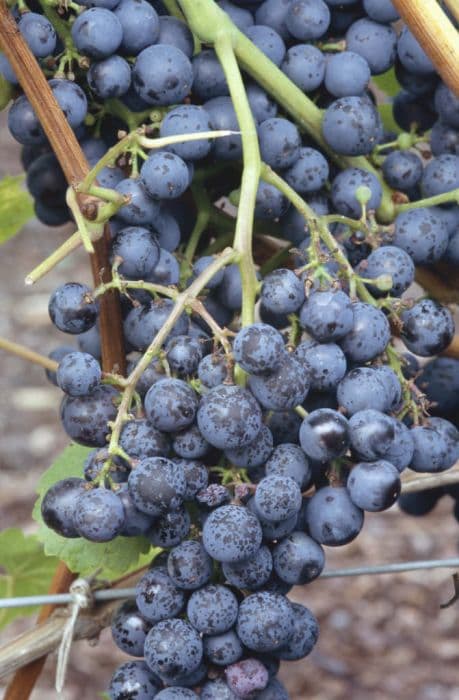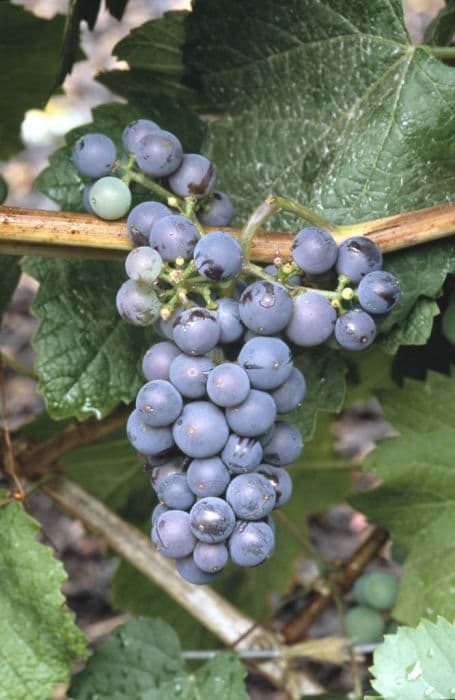Grape 'Schiava Grossa' Vitis vinifera 'Schiava Grossa' (G/b/d)

ABOUT
'Schiava Grossa' is a reliable, black, dessert grape with excellent flavour suitable for cultivation in an unheated greenhouse
About this plant
 Names
NamesFamily
Vitaceae
Synonyms
Trollinger, Vernatsch, Black Hamburg
Common names
Vitis vinifera 'Trollinger', Vitis vinifera 'Black Hamburg', Vitis vinifera 'Blauer Trollinger', Vitis vinifera 'Frankenthal', Vitis vinifera 'Frankenthaler', Vitis vinifera 'Grossa', Vitis vinifera 'Grossa di Trento', Vitis vinifera 'Grosso', Vitis vinifera 'Olivette Noire', Vitis vinifera 'Schiava', Vitis vinifera 'Schiava Grossa', Vitis vinifera 'Schiavone', Vitis vinifera 'Trentiner', Vitis vinifera 'Vernatsch', Vitis vinifera 'Weihenstephaner'.
 Characteristics
CharacteristicsLife cycle
Perennials
Foliage type
Deciduous
Color of leaves
Green
Flower color
Greenish-yellow
Height
10-15 feet (3-4.5 meters)
Spread
10-15 feet (3-4.5 meters)
Plant type
Climber
Hardiness zones
7-10
Native area
Mediterranean
Benefits
 General Benefits
General Benefits- Economic Value: The grapevine cultivar 'Schiava Grossa' is used for wine production, contributing to the agricultural and wine industry economy.
- Aesthetic Appeal: With its large leaves and bunches of grapes, 'Schiava Grossa' adds beauty to vineyards and landscapes.
- Cultural Significance: As a traditional grape variety, it plays a role in local heritage and enology, especially in regions where it has been cultivated for centuries.
- Food Source: The grapes of 'Schiava Grossa' can be consumed fresh or used in cooking, providing a natural and sweet food source.
- Ecosystem Support: As part of a vineyard ecosystem, it provides habitat and food for a variety of organisms, contributing to biodiversity.
- Soil Stabilization: The root system of grapevines can help prevent soil erosion, especially on slopes where they are often planted.
- Cooling Effect: Through transpiration, grapevines can help moderate microclimates within vineyards, which can be beneficial during hot seasons.
- Pollinator Attraction: Flowers of the grapevine attract bees and other pollinators, which are vital for the health of many ecosystems.
 Medical Properties
Medical Properties- Antioxidant activity: Vitis vinifera contains flavonoids and resveratrol which are known to have antioxidant properties, helping to neutralize free radicals in the body.
- Cardiovascular health: Components such as resveratrol may support heart health by improving blood vessel function and reducing inflammation.
- Anti-inflammatory effects: The anti-inflammatory properties of Vitis vinifera may help reduce the risk of certain chronic diseases associated with inflammation.
- Antimicrobial properties: Extracts from Vitis vinifera can be effective against various bacteria and fungi, contributing to its potential use in treating infections.
- Anti-cancer potential: Preliminary research indicates that compounds in Vitis vinifera, particularly resveratrol, might have anti-cancer effects, though more studies are needed to confirm this.
 Air-purifying Qualities
Air-purifying QualitiesThis plant is not specifically known for air purifying qualities.
 Other Uses
Other Uses- Vine training systems demonstrations: Vitis vinifera, commonly known as grapevine, can be used in academic and research settings to demonstrate various vine training and trellising techniques.
- Shade provision in pergolas: The grapevine's dense foliage can create a natural canopy over pergolas, offering a shaded area to relax under during warm seasons.
- Eco-friendly dye: The skin of the grape can be used in natural dye production for coloring fabrics and materials with a range of purple and blue hues.
- Crafting material: Dried vines can be woven into baskets, wreaths, or other decorative items, showcasing its flexibility and strength.
- Garden landscaping: Grapevine can be utilized for aesthetic purposes in landscaping, to add greenery on fences, walls, or as freestanding structures in gardens.
- Erosion control: Planting grapevines on slopes can help prevent soil erosion by stabilizing the ground with their root system.
- Culinary experimentation: Young grapevine leaves can be used in cooking, often stuffed with a mixture of rice, meat, and spices in Mediterranean cuisine.
- Homemade vinegars: Overripe grapes from the grapevine can be fermented to produce vinegars for cooking or cleaning purposes.
- Art projects: Grapevines can be incorporated into art installations or used by artists as a medium for eco-art, intertwining nature with creativity.
- Biomass production: Pruned grapevine branches can serve as biomass for the production of renewable energy or as organic mulch for gardens.
Interesting Facts
 Feng Shui
Feng ShuiThe grapevine is not used in Feng Shui practice.
 Zodiac Sign Compitability
Zodiac Sign CompitabilityThe grapevine is not used in astrology practice.
 Plant Symbolism
Plant Symbolism- Fertility: The grapevine is historically associated with fertility and abundance due to its fruitfulness and prolific nature.
- Vitality: As a plant that can live for many years while producing fruit, grapevines symbolize vitality and long-lasting life.
- Transformation: Since grapes undergo transformation to become wine, the grapevine can represent change and the ability to evolve or refine oneself.
- Dionysian Pleasures: Linked to Dionysus or Bacchus, the god of wine, grapevines are often symbols of celebration, joy, and indulgence in life's pleasures.
- Prosperity: As a crop that has historically been valuable, grapevines often denote prosperity and success.
 Water
WaterGrapevines, including the Schiava Grossa variety, require regular watering, especially during the first few years to establish a strong root system. They should be watered deeply about once a week, with approximately 5 gallons per vine, depending on the climate and soil conditions. During hot or dry periods, increase the watering frequency to prevent stress. Reduce watering as the grapevines mature and rely on rainfall unless there are prolonged dry spells. Over-watering can lead to root diseases and should be avoided; ensure proper soil drainage.
 Light
LightSchiava Grossa grapevines thrive best in full sun conditions, receiving at least 6-8 hours of direct sunlight each day. Plant them in a location where they are exposed to ample sunshine throughout the day to ensure vigorous growth and optimal fruit production. Avoid shaded areas which can inhibit the vines' development and fruit quality.
 Temperature
TemperatureThe Schiava Grossa grapevine variety performs well in a range of temperatures, but it's essential to avoid extreme conditions. They can generally withstand winter temperatures down to around 20°F and summer temperatures well into the 90s°F. The ideal temperature range for growing grapevines is between 55°F and 75°F which promotes healthy growth and fruit development. Sudden temperature drops below 20°F can damage the vines.
 Pruning
PruningSchiava Grossa grapevines should be pruned to maintain vine structure, improve air circulation and expose the fruit to adequate sunlight for ripening. Pruning is typically done in late winter or early spring before bud break when vines are dormant. Thinning out crowded shoots and removing dead or diseased wood annually will promote healthier vines and better yields.
 Cleaning
CleaningAs needed
 Soil
SoilThe grape variety commonly known as Schiava Grosso thrives in well-draining, loamy soil with a pH ranging from 5.5 to 6.5. A soil mix ideal for this variety would typically contain two parts loam, one part sand or perlite, and one part compost to provide the necessary nutrients. Additionally, incorporating organic matter into the soil can enhance its structure and fertility, supporting robust vine growth.
 Repotting
RepottingSchiava Grosso grapevines, typically grown outdoors, do not require frequent repotting. In the event they are grown in containers, repotting should be done every 2-3 years in the early spring. This allows the plant to replenish its nutrients and expand its root system within a larger space, promoting healthier growth.
 Humidity & Misting
Humidity & MistingSchiava Grosso grapevines are adaptable to a range of humidity conditions but prefer a moderate level. Maintaining a humidity level of around 40-60% is beneficial for these vines, especially during the growing season. Ensure good air circulation around the plants to prevent fungal diseases that can arise in high humidity environments.
 Suitable locations
Suitable locationsIndoor
Keep Schiava Grosso in a sunny spot; water when soil's dry.
Outdoor
Plant Schiava Grosso in full sun with well-draining soil.
Hardiness zone
7-10 USDA
 Life cycle
Life cycleThe life cycle of Vitis vinifera 'Schiava Grossa', commonly known as the "Schiava Grossa" grapevine, begins with seed germination, which occurs in a suitable environment of warmth and moisture, leading to the growth of a young grapevine. After germination, the young vine enters a vigorous period of vegetative growth, developing a root system, trunk, and canes. As the grapevine matures, it progresses to the flowering stage, where small clusters of flowers develop and are pollinated, with successful pollination leading to the formation of grape berries. The berries go through a growth and ripening phase, changing in color and accumulating sugars until they reach the harvestable stage. After harvest, the grapevine enters a dormancy period during colder months, where it conserves energy and prepares for the next growing season. Throughout its lifespan, the vineyard manager prunes and trains the vine to ensure optimal growth and fruit production, repeating this life cycle annually in a managed agricultural setting.
 Propogation
PropogationPropogation time
Late Winter - Early Spring
Propogation: The most popular method of propagating Vitis vinifera 'Schiava Grossa', commonly known as grapevine, is through hardwood cuttings. This is typically done during the dormant season, which falls in late winter to early spring. To propagate by this method, one selects a healthy cane from the previous year's growth and cuts it into segments about 9 to 12 inches (approximately 23 to 30 centimeters) long. Each cutting should have at least two or three buds. The cuttings are then planted in well-draining soil with the top bud just above the soil surface, and the lower end dipped in rooting hormone to encourage root growth. They require consistent moisture until the roots are established, after which they can be transplanted to their final growing location.

![Grape [Claret Cloak]](/_next/image?url=https%3A%2F%2Fplants-admin.emdemapps.com%2Fimages%2Fplants%2F%2Fimages%2F604b602abe2f8.png&w=640&q=75)







